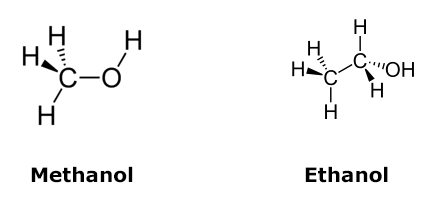Quantifying Methanol in Ethanol using Raman Spectroscopy
There is no doubt that Raman spectroscopy is an extremely powerful tool for the amateur to confirm the identity of a chemical compound that was synthesized. In this post I will show that our DIY Raman spectrometer is also able to deliver quantitative results with a high accuracy. More precisely, I will show that our OpenRAMAN spectrometer is able to detect traces of methanol in ethanol!
Detecting small amounts of methanol in ethanol is an excellent demonstration of the capabilities of the instrument because the two molecules are extremely similar chemically speaking and behaves almost identically. This makes the discrimination between the two molecules quite hard to perform using traditional lab techniques without expensive equipment like chromatographs. Distillation is probably the only economical way to separate methanol from ethanol but it is impractical to quantify accurately traces amounts. The structural formula of methanol (MeOH) and ethanol (EtOH) are given in Figure 1. Confusing the two can have deadly consequences as the second is liquor alcohol while the first is a strong poison!

Although the chemical behaviour of the two molecules are nearly identical, they have different vibrational modes due to the presence (or absence) of the -CH2– group. This difference in vibrational modes are accessible in Raman spectroscopy and the Raman spectra of the two molecules are shown in Figure 2.

The two Raman spectra differs enough to attempt an experiment! This is precisely what I have done here.
The overall idea is that a mixture of EtOH and MeOH has a spectrum that is a weighted sum of the spectra of pure EtOH and pure MeOH:

with smix,th(λ) the expected spectrum of the mixture, sMeOH(λ) the spectrum of pure methanol and sEtOH(λ) the spectrum of pure ethanol.
At this point I have made no assumptions on how α varies with the mixture ratio in weight%. Experiment will show the trend. If you are wondering why I haven’t made any a-priori hypothesis is because it was unclear if the parameter should depend linearly (or not?) on the mixture ratio in either weight% or volume%. Compounds like MeOH and EtOH are prone to interact and the relationship between weight% and volume% is not strictly linear so we must be careful.
In the experiment, I have measured the spectra of pure ethanol and pure methanol as well as the spectra of 10 mixtures for which I knew the mix ratio in weight% using a precision scale. The idea is to plot the value of α against the known weight% and to check the trend and error. The value of α can be computed using a least-square approach from the experimental mixture spectrum smix,exp(λ):


Solving gives:

Note that the same method can be used for ternary, quaternary… mixtures as well but the equations gets a bit more complex. I will make a detailed post about least-square methods when I have more time.
When performing the experiment, I however ran into a problem with fluorescence. If you look at Figure 2 you can see that the two spectra have different backgrounds (which are supposed to due to fluorescence). Interestingly, I noticed that mixture of methanol and ethanol exhibited even more fluorescence! The presence of this odd background ruined the theoretical model of the mixture, making the parameter α unmeaningful. To solve this issue, I tested several methods including bspline background removal, bandpass filtering and gradients fit. The best results were obtained by a bandpass filtering of 3-15 px (6-28 cm-1) of all the spectra. The experimental results are shown in Figure 3 along with the y=x line. One of the experimental points had to be removed (marked with a cross). It is unclear what went wrong with that point.

From the experimental results, a simple y=x model gave 0.6% median error while a best-line fit using the leave-1-out method gave a 0.8% median error. The trend is clearly linear and we can therefore make the conclusion that α correlates extremely well with the weight% of methanol. Concerning the 0.6% error, it corresponds to the precision at which I performed the dilution. Although my scale has a 5 mg accuracy (which would already give a 0.4% error in this experiment), I noticed that I did not always emptied the vial fully and from experiments to experiments and I had to re-zero my balance with weight differences on the order of 15-20 mg. This gives an estimated dilution error of about 1-1.5% which is on the order of what we observe on Figure 3. The results are therefore extremely encouraging as we have proven that our DIY Raman setup is able to quantify amounts down to 1% or less of methanol in ethanol reliably. The method is probably more precise than that and our conclusions are limited here by the accuracy at which I performed the dilutions. Nonetheless, this is extremely good results!
1 Comment
Evidence of Bisulfite Addition to Aldehydes using Raman Spectroscopy – OpenRAMAN · February 3, 2020 at 5:59 pm
[…] already shown how you can discriminate small amount of methanol in ethanol or how you can track the kinetic of a reaction. Today I will show how you can prove a reaction that […]